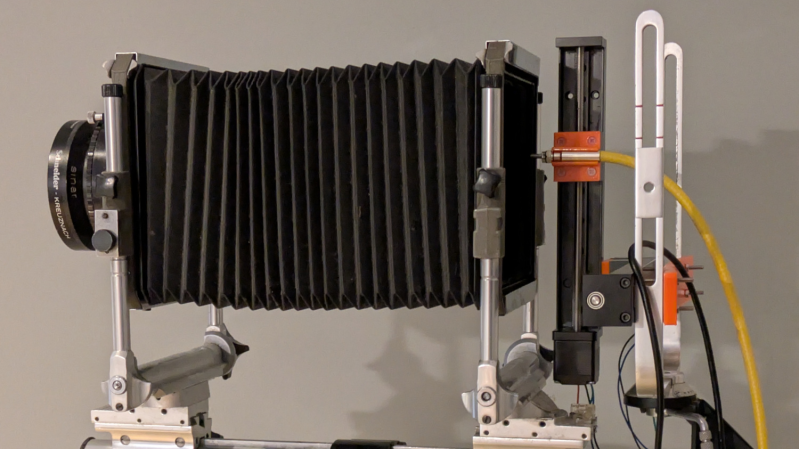Hyperspectral cameras aren’t commonplace items; they capture spectral data for each of their pixels. While commercial hyperspectral cameras often start in the tens of thousands of dollars, [anfractuosity] decided to make his own with the Waverider.
To capture spectral data from every pixel location in the camera, [anfractuosity] first needed a way to collect that data — for that, he used an AFBR-S20M2WV, a miniature USB spectrometer he picked up second-hand. This sensor allows for the collection of data from 225 nm all the way up to 1000 nm. Of course, the sensor can only do that for one single input, so to turn it into a camera, [anfractuosity] added a stepper-driven x-y stage controlled by a Raspberry Pi Pico and some TMC2130 stepper drivers.
With some 3D-printed parts to hold things together and a fiber-optic cable, [anfractuosity] now had a way to move the one-pixel camera through a wide range of locations, turning that one pixel into a much larger pixel array needed to get a recognizable image out. It’s not the fastest camera we’ve seen — with one 400 × 400 array of images taking almost 19 hours to capture — but it does produce an image that has far more than one RGB value per pixel.
Head over to [anfractuosity]’s site to check out all the images created and to find out more about this project, and check out some of our other single-pixel camera projects we’ve featured in the past. Or, maybe you can use your phone.
















I’m curious if you could make this faster with a mirror array pulled out of a DLP device.
You make this faster by using a normal 2-D detector with a grating and the usual slit: Scan that slit across the focal plane and get a whole line of data at a time. Though often simpler to just rotate the camera body. Easily a thousand times faster than this method.
The problem is you’d need a 4×5 sensor to do this with the same type of lens. And 4×5 lenses are by far the easiest to hack like this. That’s not even close to cheap. If you use a linear sensor you still need to step it across the slit at each step so it’s pretty much the same thing.
Nobody says you need to use such a ridiculously huge lens. It works as well or better with normal DSLR lenses: Faster glass, better aberration control in inexpensive lenses.
Agreed, though, when you get down to C-mount or M12 lenses, you start to compromise on resolution due to slit width.
The single-pixel spectrometer featured above already uses a linear detector. That’s why it’s so slow. Adding the second dimension by using a normal 2-D camera sensor removes one required degree of freedom in the motion, multiplies the collection area by a factor of a thousand or more, and speeds up the acquisition accordingly.
You don’t even have to scan the focal plane of the lens with the sensor: It’s easier to keep the lens/sensor/spectrometer all fixed, and rotate the whole camera.
So maybe an m42 mount for access to lenses with bad coatings and manual diaphragms with a full frame mirrorless behind it and some sort of scanning diffraction slit between them?
Toshiba TCD1702C 7500 elements, TCD1705D 7450 elements. NEC μPD3768 is color but you might strip the filters. Maybe there is a monochrome equivalent. 7500 pixels and 69mm long.
Man, I think I still have some of those. Used them on medium format bodies sometime in the late 90s. Predecessors to me used lower resolution ones in the mid 80s. The clock generator boards alone were full of discrete logic and were 4″x8″. Now you would just bitbang them with a FPGA. Or a Teensy, for the trogolodytes.
Yes, I have some taken from old scanners and off eBay. The fast 12bit ADC in STM32F407 types is fine and you can do DMA with it. I saw a guy….got it. Not as many wires as you might think! https://curiousscientist.tech/blog/tcd1703-linear-ccd-driving-and-reading
you can it was done by Ting Sun and Kevin Kelly in 2009
Sun, T., & Kelly, K. (2009, October). Compressive sensing hyperspectral imager. In Computational Optical Sensing and Imaging (p. CTuA5). Optica Publishing Group.
the Kelly group has since made a single pixel hyperspectral video camera
Xu, Y., Lu, L., Saragadam, V., & Kelly, K. F. (2024). A compressive hyperspectral video imaging system using a single-pixel detector. Nature Communications, 15(1), 1456.
better by hyperspectral camera it will be cheaper than DLP 😂😂😂 Israeliams make hyperspectral miniature camera with b/w sensor and small tunable filter ,most probably Fabry Perrot
Cool idea, if slow. Another thing to keep in mind is that the lens wasn’t designed for the full bandwidth of the spectrometer. It has coatings on it that won’t transmit some wavelengths as well (can be calibrated out), and also likely has chromatic aberrations beyond the visible spectrum (and probably some within). Not a deal-breaker, just something to be mindful of with this kind of hacked together rig. Well done!
It is large format. So that lens could probably be replaced by one that’s older than coatings.
Awesome results! I wonder if you could just use an ordinary camera and then illuminate the scene with a monochromator to get identical results.
If you want to image into UV, be aware that most glass lenses and photographic lens coatings are not very transparent well into UV. Reflective or quartz optics are a couple of the solutions.
I was wondering if a pin hole camera would work better over this range of wave lengths?